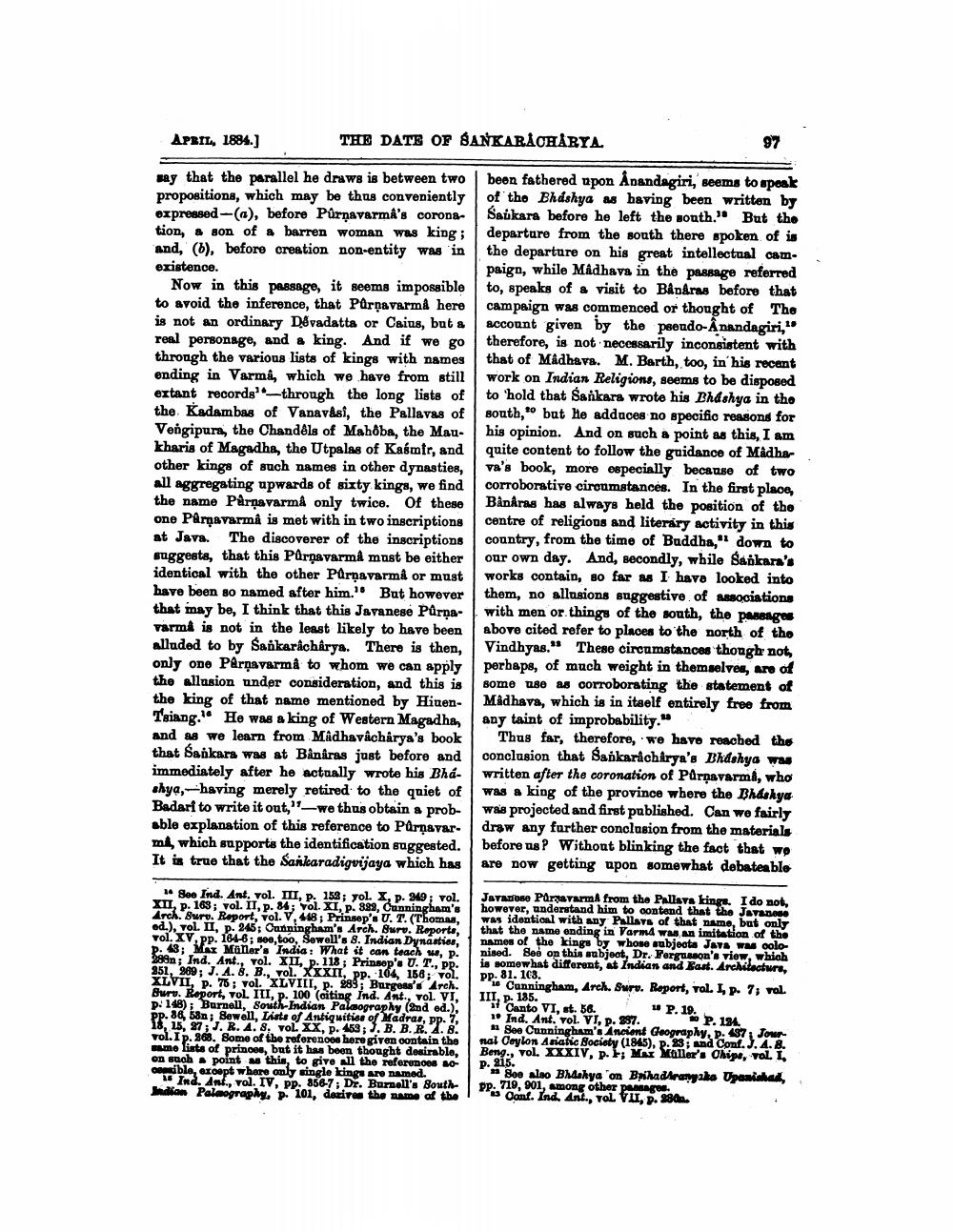________________
APRIL, 1884.)
THE DATE OF BANKARÁCHÅBYA.
97
say that the parallel he draws is between two propositions, which may be thus conveniently expressed-(a), before Purnavarma's coronation, & son of a barren woman was king; and, (b), before creation non-entity was in existence.
Now in this passage, it seems impossible to avoid the inference, that Pārņavarma here is not an ordinary Devadatta or Caius, but a real personage, and a king. And if we go through the various lists of kings with names ending in Varma, which we have from still extant records' through the long lists of the Kadambas of Vanavasi, the Pallaves of Vengipura, the Chandels of Mahâba, the Mau. kharis of Magadha, the Utpalas of Kasmir, and other kings of such names in other dynasties, all aggregating upwards of sixty kings, we find the name Parnavarma only twice. Of these one Parnavarma is met with in two inscriptions at Java. The discoverer of the inscriptions suggests, that this Pärnavarma must be either identical with the other Porņavarma or must have been so named after him." But however that may be, I think that this Javanese Parna- varmi is not in the least likely to have been alluded to by Sankaracharya. There is then, only ono PArņavarma to whom we can apply the allusion under consideration, and this is the king of that name mentioned by HinenTsiang. He was a king of Western Magadha, and as we learn from Madhavacharya's book that Sankara was at Bảniras just before and immediately after he actually wrote his Bhá- shya, having merely retired to the quiet of Badari to write it out,"-we thus obtain a probable explanation of this reference to Parņavarml, which supports the identification suggested. It is true that the Sankaradigvijaya which has
been fathered upon Anandagiri, seems to speak of the Bhdshya as having been written by Saúkara before he left the south." But the departure from the south there spoken of is the departure on his great intellectual cam. paign, while Madhava in the passage referred to, speaks of a visit to Båneras before that campaign was commenced or thought of The account given by the peendo-Anandagiri," therefore, is not necessarily inconsistent with that of Madhava. M. Barth, too, in his recent work on Indian Religions, seems to be disposed to 'hold that Sankara wrote his Bhdshya in the south, but he adduces no specifio reasons for his opinion. And on such a point as this, I am quite content to follow the guidance of Madhar va's book, more especially because of two corroborative circumstances. In the first place, Banaras has always held the position of the centre of religions and literary activity in this country, from the time of Buddha," down to our own day. And, secondly, while Sankara's works contain, so far as I have looked into them, no allusions suggestive of Associations with men or things of the south, the passages above cited refer to places to the north of the Vindhyas." These circumstances though not perhaps, of much weight in themselves, are of some use as corroborating the statement of Madhava, which is in itaelf entirely free from any taint of improbability."
Thus far, therefore, we have reached the conclusion that Sankaricharya's Bhdshya was written after the coronation of Parnavarma, who was a king of the province where the Bhashya was projected and first published. Can we fairly draw any further conclusion from the materials before us? Without blinking the fact that we are now getting upon somewhat debateable
Seo Ind. Ant. vol. II, p. 152; yol. X, p. 249; vol. XII, p. 163; vol. II, p. 84: Yol. XI, p. 889, Cunningham's Arch. Suru. Report, vol. V, 448Prinsep'. U.T. (Thomas, od.), vol. II, p. 245; Canningham's Arch. Surv. Reporta, vol. XV, pp. 164-8; see, too, Sewell's 8. Indian Dynasties, p. 43; Max Maner's India: What it can teach w, p. 28an; Ind. Ant., vol. XI, p. 118; Prinsop'. U. T., pp. 251,969; J. A. 8. B., vol. XXXII, pp. 164, 158; Vol. XLVII, p. 76 ; vol. XLVIII, p. 289; Burgess's Arch. Burt. Report, VOL III, P. 100 (citing Ind. Ant., vol. VI, p. 148) Barnell, South Indian Palaography (2nd ed.), pp. 86, 58n; Bewall, Lists of Antiquitis of Madras, pp. 7, 18, 15, 27; J. R. A. 8. vol. XX, p. 453; J. B. B.R. 2.8. vol. I p. 368. Bome of the reference here given contain the mamo lists of princes, but it has been thought desirable, on such point as this, to give all the references ao
blo, except where only single kings are named. Ind. ant., vol. IV, pp. 8567, Dr. Burnell's South
Pellagraph. 101, delires the sum of the
JATA Parga varmA from the Pallars kings. I do not, however, understand him to contend that the Japanese was identical with any Pallars of that name, but only
that the name ending in Varmd was an imitation of the 1 names of the kings by whose subjecta Jara wus colo nised. Sed on this subject, Dr. Verguson's view, which is somewhat different, at Indians and East. Architecture, Pp. 81. 108. *SCunningham, Arch. Suru. Report, vol. I, p. 7, vol. III, p. 185. 11 Canto VI, st. 56.
P. 19. * Ind. Ant. vol. VI, p. 387.
P. 18. # See Cunningham's Ancient Geography, p. 187 Jour nal Ceylon Asiatic Society (1845), P. 13; And Conf. J. 4.8. Beng., vol. XXXIV, p. ; Mar Miller's Chipe, vol. 1
Soo slao Bhdekya on Brihadirangaika Upanishad, Pp. 719, 901, among other page.
Conf. Ind. ant., rol vu, p. 988
P. 215.




